Survey Details
 Report Authors:
Report Authors:
- Justin S. Vaughn, Ph.D.
- Jeffrey Lyons, Ph.D.
- Matthew May, Ph.D.
About
The Fourth Annual Idaho Public Policy Survey was conducted December 10th to January 8th and surveyed 1,004 adults currently living in the state of Idaho. The sample is designed to be representative of the population, using a random-digit dialing sampling approach, with 60% of the respondents contacted on cell-phones to increase our coverage of the population. People were asked about their attitudes on the main issues and priorities facing the state, education, budget and taxes, criminal justice, and the environment. The sampling margin of error is 3.1%.
Key Findings
- Idahoans remain generally satisfied with the direction that the state is headed in and are optimistic about the economy, but see education as the most important issue that needs to be addressed.
- Evaluations of the quality of K-12 education in the state are mixed, with sizeable numbers believing that quality is fair or poor.
- Respondents are generally in favor of increasing state funding for early childhood education, but not if it is done by reducing spending on education in other places.
- Idahoans are largely satisfied with the level of state spending and the level of taxation. Majorities favor either no changes or just small ones when it comes to Idaho’s tax system.
- The majority of Idahoans are supportive of allowing cities to vote on local option taxes, though when asked if they would vote in favor of such measures the public is divided.
- Opinions on sentencing for those convicted of crimes are mixed, but majorities appear to be supportive of giving minimum and maximum sentencing guidance to judges.
- Majorities support the goal of having the state transition to 100% clean energy by 2050, but this support is reduced if it means higher power bills.
- Idahoans are the most supportive of using more solar energy, and an overwhelming majority are in favor of allowing homeowners with solar units to receive credits on their electricity bill for energy that they add to the grid.
We begin by looking at the general sentiments that Idahoans have about the direction that the state is heading in, and the challenges that it faces. First, we ask people whether they think that things in Idaho are generally headed in the right direction, or are on the wrong track. We find that the majority of residents feel that the state is headed in the right direction (59.4%), with less than one in three feeling that it is on the wrong track (29.6%). This general feeling of optimism is stronger amongst Republicans than Democrats – 73.0% of Republicans feel the state is on the right track compared to 42.0% of Democrats. These numbers are almost identical to when this question was asked last year, suggesting that satisfaction with the direction of the state is unchanged.
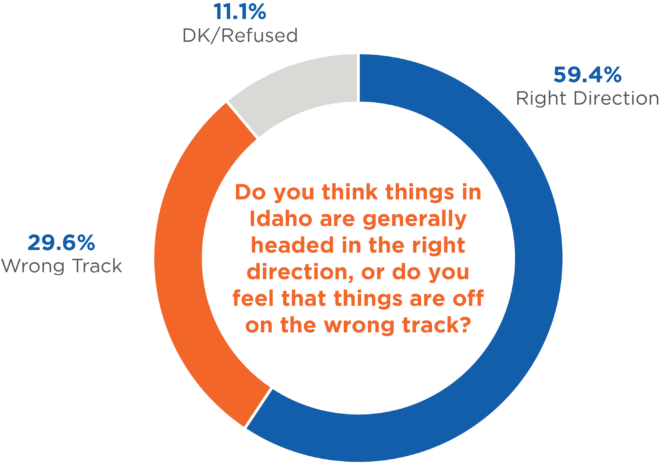
In addition to assessing the direction the state is headed in general, we want to know if people are optimistic about the economic future of the state. We asked respondents if they thought the Idaho economy was going to get better, worse, or stay about the same over the next two years. In general, perceptions are fairly optimistic with the vast majority saying it will either stay about the same (42.2%) or get better (40.2%). A relatively small share of Idahoans are more pessimistic – 15.0% said that they believed it would get worse. These numbers are similar to those from our 2018 survey. There are partisan differences in optimism about the economy, with 46.6% of Republicans believing that it will get better, while 29.6% of Democrats share that view. While Idahoans are generally satisfied with the direction of the state and are optimistic about the economy, we wanted to understand what issues they see as being the most important. To measure this, we ask an open ended question to the respondents where they come up with the
issue that they think is the most important on their own, without being presented with a list of possible issues. Once the respondents give their comments, we group them by issue to see which matters are on the minds of people. When we do this, we find that education tops the list, with 24.7% of Idahoans mentioning education in some fashion. The next most common responses were the economy (15.1%) and healthcare (13.0%). Looking to the most important issues that were mentioned in the 2018 survey, we saw these same three issues top the list. The percentage who responded with education and the economy are essentially unchanged from last year, but the number indicating that healthcare is the biggest issue is up from 7.5%.
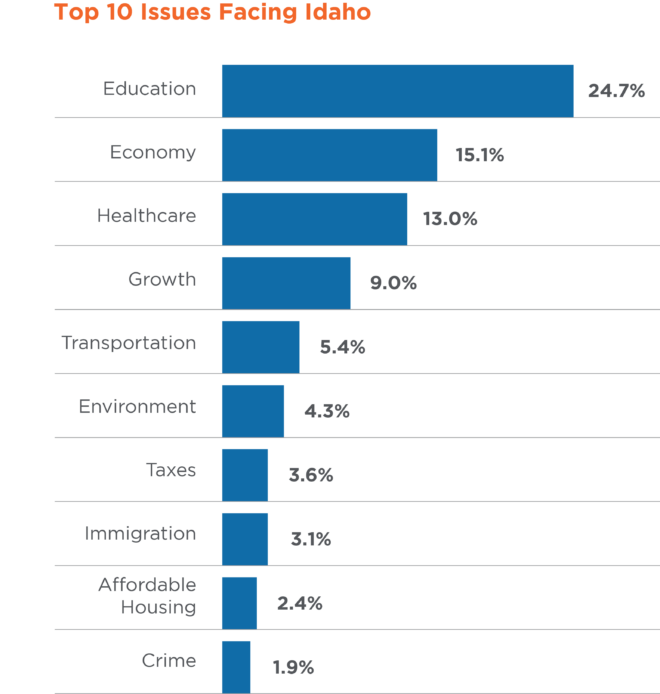
The next set of issues that were mentioned most frequently are growth (9.0%), transportation (5.4%) and the environment (4.3%). All three of these issues experienced an increase in the share who reported that they were the most important issue facing the state since last year. Rounding out the top 10 issues that were mentioned are taxes (3.6%), immigration (3.1%), affordable housing (2.4%), and crime (1.9%). While these are the issues that people mention as being the most important in the state, we also want to know Idahoans’ perceptions of the importance of the legislature addressing different matters. To do this, we present people with a series of possible issues that the legislature could take up, and ask them to indicate on a 1-10 scale how important it is for the legislature to address. We see that education appears to be seen as the most important issue for the legislature to address, with an average score of 8.8, followed by jobs and the economy (8.1), healthcare (7.9), naturalresources (7.7), the environment (7.5), taxes (7.1), immigration (6.8), and transportation (6.6). The ranking of issues is very similar to what we found in last year’s survey – the top three issues are the same as they were in 2018, though healthcare and jobs and the economy switched places. Further, the bottom two issues this year – immigration and transportation – were also the bottom two issues last year.
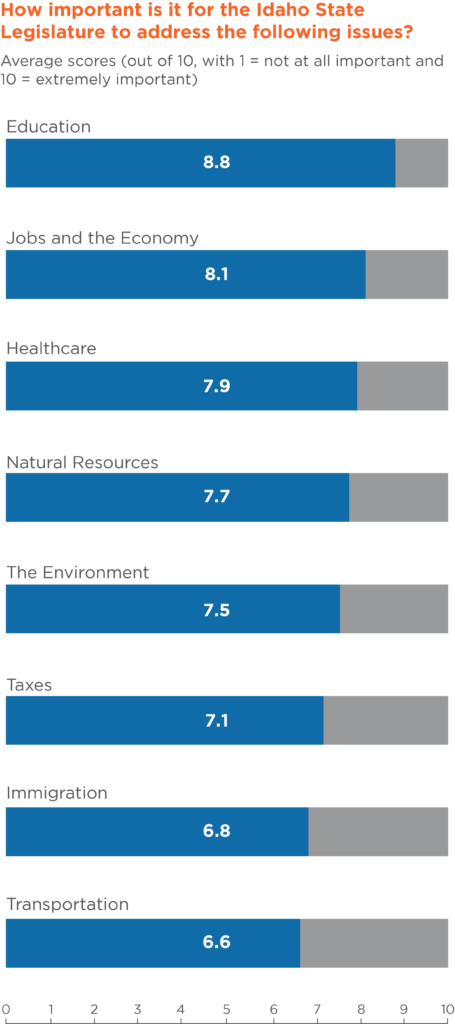
As we have seen, education is one of the top issues facing the state and one of the priorities that people would like the Idaho legislature to address. Some of this perceived importance may be due to the perceptions of the quality of education. When asked how they would rate the quality of Idaho’s K-12 education system, less than one third (31.9%) believe it to be either good or excellent. The most common response (37.1%) was that it is fair, with over a quarter (27.3%) believing that K-12 education is poor. Younger respondents were more likely to believe that the quality of education is poor than older ones – 35.2% of those from ages 18-34 believe the quality is poor compared to 17.2% of those over the age of 80. These are very similar to the perceptions that we found in the 2018 Idaho Public Policy Survey.
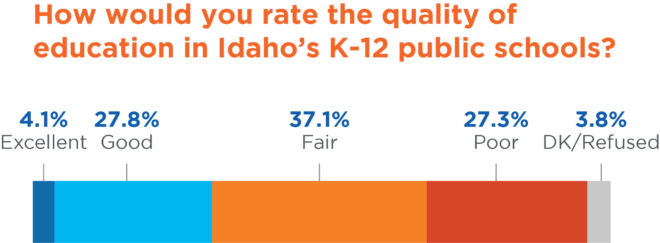
Because it is possible that people hold different beliefs about the quality of education in their area compared to the state as a whole, we also ask how they would assess the quality of education in their area. We find slightly more positive assessments when the focus is on one’s area. The most common response (35.2%) is that the quality is good, and 45.1% say that the quality is either good or excellent. However, a large percentage still hold more pessimistic views. 31.6% of respondents felt that the quality in their area was fair, and 17.0% said that it was poor. When grouped together, almost half (48.6%) believed the schools in their area to be either fair or poor. As we saw with perceptions about the state as a whole, younger Idahoans were more negative about the quality of education in their area – 23.1% of those between 18-34 said that it was poor, while only 10.3% of those over 80 said the same. Attitudes on this question were also very similar to what we found when asking the same question in 2018.
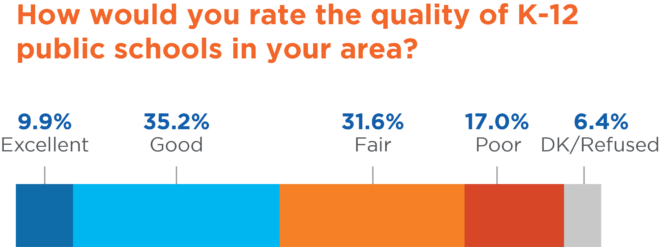
Next, we wanted to know what people thought about the job that schools are doing in preparing their students for education beyond high school. Again, we were interested in perceptions at the
statewide level, and in the respondent’s area. Rather than ask two separate questions, we split the sample, so half the respondents were asked about the job that schools across the state were doing, while half were asked about the job that schools in their area were doing. Looking first to the responses for those who were asked about schools in the state as a whole, we see very similar attitudes to when we asked about the quality of K-12 education. Very few (4.4%) believe that schools are doing an excellent job preparing students for education beyond high school, but a more sizeable group (30.2%) feel that they are doing a good job. The most common response was that they are doing a fair job (36.3%), and almost a quarter (24.4%) said that they are doing a poor job. Grouping together the fair and poor attitudes, we see that a majority of respondents (60.7%) hold less than positive views. Once again, age is one of the factors that divides attitudes
the most, with 31.3% of those between 18- 34 saying that schools are doing a poor job, and only 9.4% of those over 80 saying the same. These results are similar to what we found in 2018, again suggesting relatively stable perceptions on the issue of education.
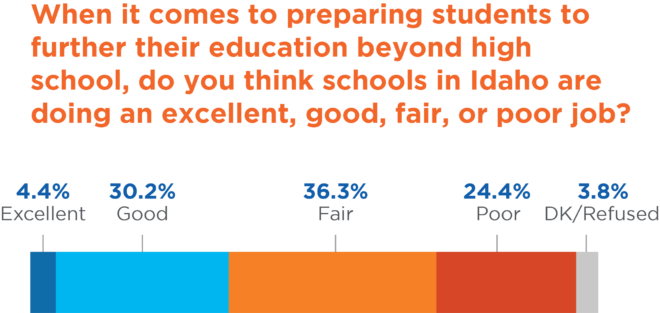
When looking to perceptions of the job that schools are doing preparing students for education beyond high school in one’s area, attitudes are generally similar, though slightly more positive. Taken together, 38.5% believe that the schools in their area are doing either an excellent or good job, while 53.0% responded either fair or poor. After looking at Idahoans’ perceptions of the quality of K-12 education, we asked about funding for early childhood education. We started by asking a general question about whether funding for early childhood education should be increased or not. We find that a majority of respondents (60.7%) believe that funding should be increased, while about one-third (33.7%) responded that funding should not be increased. A sizeable majority of Democrats (82.8%) believe that funding should be increased, while Republicans are divided (48.3% believe it should be increased and 45.8% believe it should not). While these findings demonstrate support for the idea of increased funding, we turn to seeing if this support holds under different conditions. We do this by splitting our sample into three groups and asking slightly different questions to each group. In the first group we ask whether the respondent would support increasing funding for early childhood education if it meant paying more in taxes. When framed this way, we see that support falls but a majority of respondents (54.2%) still favor increasing funding, and a sizeable minority (40.5%) oppose it.
Younger respondents are the most likely to favor increased funding even if it means raising taxes (61.0% of those from 18-34 favor), while middle-aged respondents were the least supportive (44.9% of those from 50-64 favored). Democrats still favored increased funding by a sizeable margin (76% favored), as did Independents (64.8% favored), but a minority of Republicans (43.7%) were supportive.
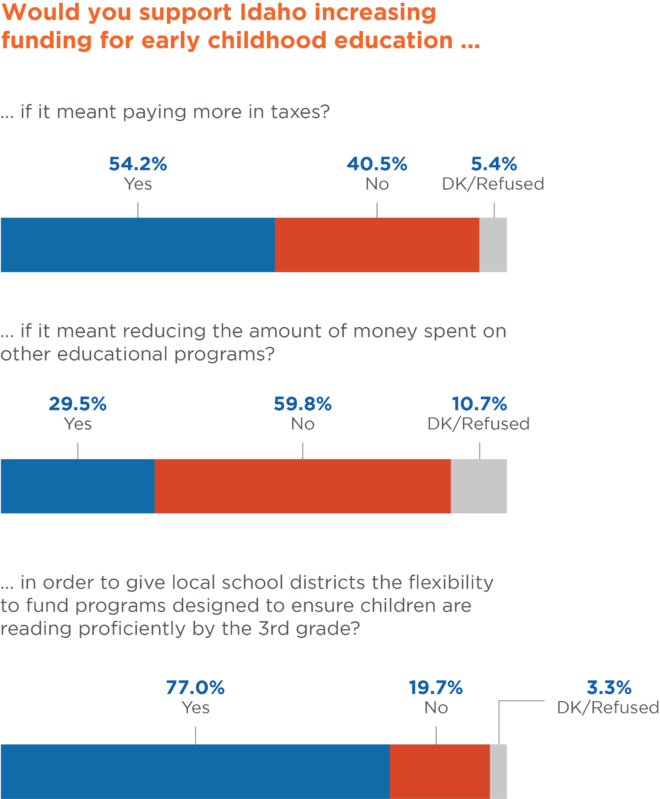
The second group of respondents were asked if they would favor increasing funding for early childhood education if it meant reducing the amount of money spent on other educational programs. When presented with this tradeoff, people are not supportive of increased funding. 29.5% still favor increasing early childhood education funding, while a majority of respondents (59.8%) said that they did not. Even among groups that were previously quite supportive of increasing funding for early childhood education such as younger individuals and Democrats, there is no longer majority support. Across all groups, and all regions of the state, this proposal is unpopular. The third group was not exposed to conditions about funding, but rather about outcomes. They were asked if they would support increased funding for early childhood education in order to give local school districts the flexibility to address reading proficiency. In this condition, we see sizeable support for increased funding. 77.0% of people stated that they would support this, while 19.7% said that they did not. There is majority support amongst Democrats (90.1%), Independents (72.7%), and Republicans (69.6%). In sum, Idahoans see room for improvement in the quality of K-12 education in the state. Majorities believe that the quality is only fair or poor, and very few think it is excellent. Similarly, majorities believe that Idaho is only doing a fair or poor job in preparing students for education beyond high school. There is support for increasing funding for early childhood education, and people are more supportive of doing this through increased taxes than they are of doing it by reducing spending on other educational programs.
With respect to Idahoans’ attitudes about the state’s fiscal environment, we start by asking a general question regarding the size of the budget. While few individuals are likely to know the details of the budget, this question serves as an indicator of general attitudes regarding the size and scope of government. When asked whether they think that the Idaho budget should be increased, decreased, or stay about the same, we find that the most common response is that it should stay about the same (42.8%). However, there is also sizeable support for increasing the size of the state budget, with 36.5% of respondents indicating that this was their preference. On
the other hand, few believe that the budget should be decreased (7.8%). It is also notable that 13.0% responded that they did not know, which is a relatively high number compared to many other questions on the survey. These numbers are very similar to those from 2018, we see no change over the past year in attitudes about the size of the Idaho budget.
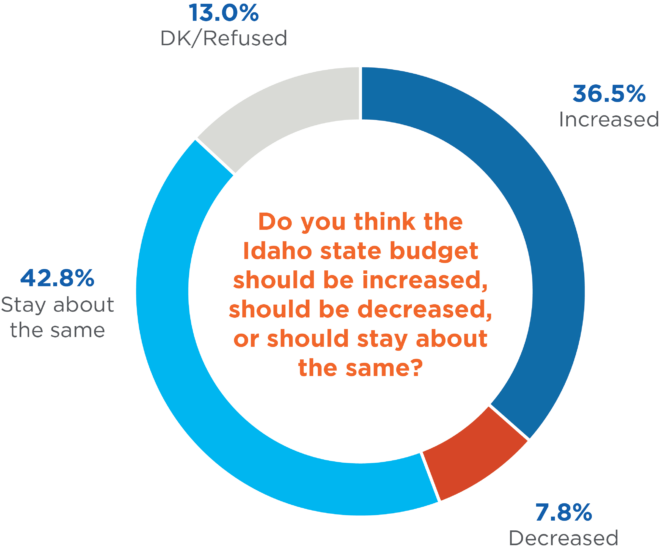
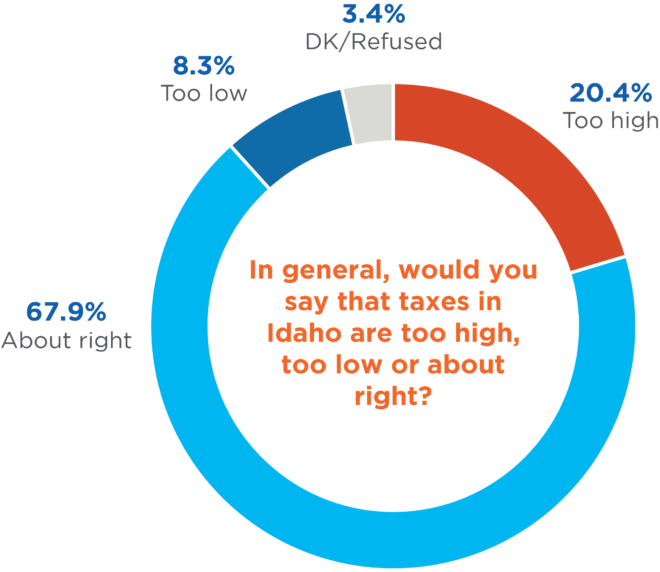
Partisan differences appear to be the most important on this matter. More than half (57.6%) of the Democrats who were polled responded that the state budget should be increased, while one quarter (25.6%) of
Republicans held that view. Conversely, a majority of Republicans (53.8%) favored keeping the budget about the same, while a little over one quarter of Democrats (28.4%) held that view. Essentially no Democrats felt that the budget should be decreased, and only 9.2% of Republicans indicated a preference for less spending. Related to the size of the budget is the
level of taxation. To assess attitudes about the level of taxation, we first ask a general question about whether taxes are too high, too low, or about right. A super majority (67.9%) of respondents indicated that taxes are about right, indicating broad support for the status quo. Roughly one in five (20.4%) believe that taxes are too high, and few (8.3%) believe that they are too low. As with the previous question, these numbers are essentially the same as what we found in the 2018 survey. This is one of the few questions where there are not large differences across any of the groups that we explored. Young and old respondents have similar attitudes, as
do men and women. While some partisan differences exist, majorities of Democrats (63.6%), Independents (63.9%), and Republicans (71.2%) felt that taxes were about right. While people tend to think that the current level of taxation is about right, that does not necessarily mean that they believe no changes should occur whatsoever. To measure this, people were asked about the magnitude of changes that they would like to see with respect to Idaho’s tax system. When framed this way, we see that the majority of Idahoans (56.1%) feel that some changes are needed, but the system should stay basically the same. About one in five people feel that more sizeable changes are needed, with 11.0% saying they preferred major changes, and 10.3% stating that a complete overhaul of the system was needed. Conversely, 15.7% reported thinking that the system works fairly well now and does not need to be change. These values are all within the margin of error from the 2018 survey suggesting that these attitudes have not changed over the past year. Though there are some differences across partisan groups, majorities of Democrats (54.8%), Independents (53.2%), and Republicans (59.1%) responded that some
changes were needed but it should stay basically the same. Republicans were more likely than Democrats to say that it works well as it is now (20.0% of Republicans compared to 8.8% of Democrats), and Democrats were more likely than Republicans to respond that major changes are needed (17.2% of Democrats compared to 7.4% of Republicans). Differences by age, gender, and region of the state were generally minimal. This raises the question of what some of
the changes to the tax system might be, and how supported they are by residents of Idaho. One change that has been discussed is giving cities in Idaho the ability to vote on whether they would like to implement “local option” taxes. Because this is a complicated matter that is unfamiliar to many, we asked the question by including information on how local option taxes work and the kinds of things that they typically go to fund. When given this information, we find that a majority of Idahoans (61.4%) favor allowing cities to vote on the implementation of local option taxes, and 33.9% oppose this. This is a slightly lower level of support than we found in 2018, when 66.1% favored allowing cities to vote, but since this difference is within the margin of error we cannot be confident that it represents an actual decline in support amongst the population.
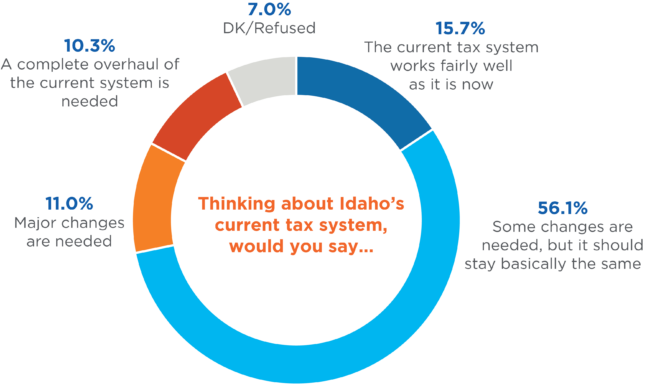
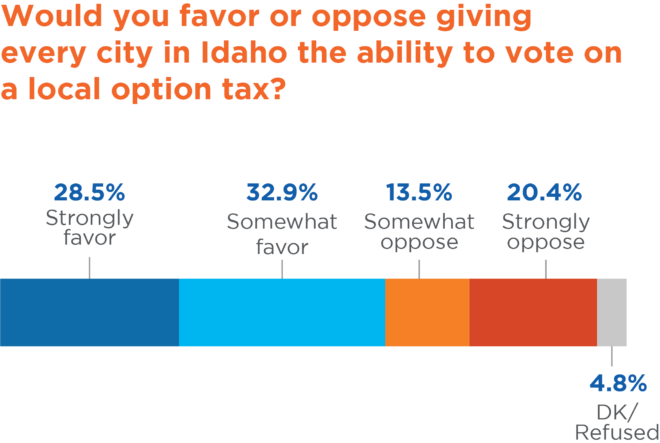
Younger Idahoans are more likely to support allowing cities to vote on local option taxes than older Idahoans are, although majorities of both groups are in favor. 69.6% of those from 18-34 years old favor allowing cities to vote on these, while 53.5% of those over the age of 80 are supportive. Democrats are more supportive than Republicans, but as with age, majorities of both groups are in favor. 72.4% of Democrats expressed support, as did 56.5% of Republicans. However, just because majorities are in favor of letting cities vote on such matters it does not mean that these measures would pass. To gauge statewide support should local option taxes appear on the ballot, we wanted to know if people would vote in favor of them in their own towns. The challenge with trying to assess support for this is that it would depend upon the details of the tax for many people. While it is not possible for us to test every possible kind of tax, we wanted to know whether people were more likely to support the tax if it was for a specific purpose. In our case, we sought to understand general support, and support if the money went to funding transportation. To do this, we split the sample as we have done previously, where half of our respondents read one version of the question, and the other half read a very similar version with the exception that it specified the money was to support the local transportation system. Looking first to the base question which asks people if they would favor or oppose a local option tax in their city, opinions are evenly divided – 46.5% say that they would favor such a proposal, and 46.3% say that they would oppose one, with 7.2% stating that they do not know. These numbers are very similar to those we received when we asked this question in 2018. Democrats are more supportive than Republicans of local option taxes, with
61.5% of Democrats supporting and 39.7% of Republicans doing so. This is also one of the few questions where we see regional differences emerge. Those who live in the Boise media market are the most supportive, with 51.3% saying that they would vote in favor of a local option tax.
When presented with the other question wording which was identical but added the language “to support the local transportation system” we see a small increase in support to 50.2%, but the
difference between this number and the level of support from the baseline question is not large enough to give us confidence that specifying transportation increases the number who would vote in favor of a local option tax. In sum, the majority of Idahoans are satisfied with the size of the budget in the state, as well as the level of taxation. When asked about changes to the tax system, people prefer small changes as opposed to more sizeable ones. With respect to local option taxes, majorities favor allowing people to vote on them, but opinions are evenly split on whether citizens would actually vote in favor of them. In general, attitudes about the budget and taxes have been quite consistent over the past year.
Criminal sentencing reform has been discussed in Idaho and throughout the country as potential means to combat rising prison populations. As a result, we asked people a series of questions about their views on sentencing. First, we focused on the amount of discretion that judges have when giving sentences. We start by asking the extent to which the respondent agrees or disagrees with judges having complete discretion when sentencing people convicted of a crime. We find that there is majority support for this idea, with 55.8% of respondents indicating that they agree with this, and 38.0% saying that they disagree. While this seems to suggest that most Idahoans believe judges should not be constrained when sentencing, the next question leads us to a conflicting conclusion. When asked whether they agree that there should be minimum and maximum limits given to judges when sentencing, we find that a sizeable majority agrees with having some limits. 71.1% of respondents agreed with the idea of having minimum and maximum limits, while only 22.4% disagreed with this idea. There are few significant differences across groups, although Republicans appear to be slightly more favorable of having minimum and maximum limits, with 74.0% of Republicans in favor, and 66.4% of Democrats in favor. While Republicans are slightly more positive about the idea, sizeable majorities of both groups are in agreement.
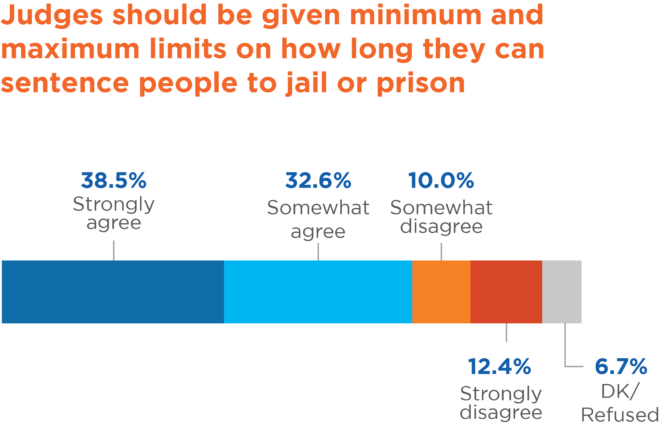
Moving away from discretion given to judges and looking at the factors that are considered when sentencing, we asked whether past crimes should be used in determining an appropriate sentence. Idahoans overwhelmingly support this idea, with 76.2% agreeing and only 18.2%
disagreeing. As with the previous question, Republicans are more supportive (82.7%) than Democrats (67.2%), but clear majorities of both groups are in favor. Next we sought to understand Idahoans’ attitudes on criminal offenders by asking whether they believe that those who commit crimes can change their behavior. This question speaks to the goals of incarceration and whether rehabilitation can be effective. We see that Idahoans overwhelmingly believe that those who commit crimes can change their behavior. Almost half (47.6%) strongly agree that they can change their behavior, and when we combine the strongly and somewhat agree categories, we see that 86.1% are in some level of agreement with the statement. Only 11.4% are in a level of disagreement. There are some differences across groups in the population. In general, younger Idahoans are more likely to respond that those who commit crimes can change their behavior. When we combine the strongly and somewhat agree categories, 92.0% of those between 18-34 agree that behaviors can be changed, and 72.4% of those over 80 share that sentiment. Moving on from issues pertaining to sentencing, we look at perceptions of criminal punishments as they currently are. When asked how they would rate the
appropriateness of criminal punishments in Idaho we see very mixed opinions. The most common response is that they are appropriate (34.7%), with very similar numbers of people believing they are too lenient (21.9%) and too harsh (22.5%). There are also a large number who respond that they do not know (20.9%).
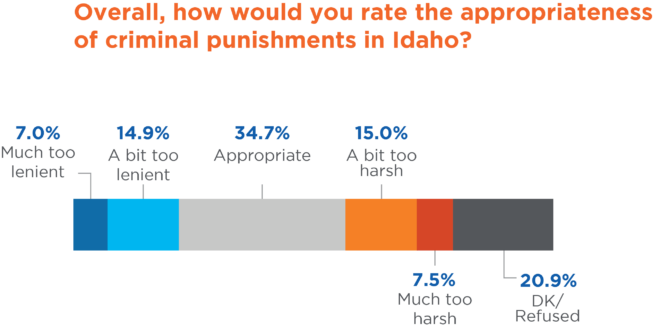
There is a partisan dimension to these opinions. Both Democrats and Republicans are similar in that the most common response for both groups is that punishments are appropriate – 34% of Democrats and 38.9% of Republicans held this view. However, Republicans were more likely than Democrats to report punishments as being too lenient (30.7% of Republicans compared to 10.0% of Democrats), and Democrats were more likely to report punishments as being too harsh (34.0% of Democrats compared to 14.0% of Republicans). There is also a regional component to these opinions, with those in the Boise media market being the most likely to say that punishments are too harsh (29.8%) and those in the Spokane media market the least likely (12.9%). In sum, opinions on sentencing are somewhat conflicted. Majorities express support for judges having complete discretion, but even larger majorities support minimum and maximum sentencing guidelines. We also find overwhelming support for past criminal behavior being used as a consideration when sentencing, and overwhelming agreement with the idea that those who have committed criminal offenses can change their behavior. With respect to the appropriateness of punishments as they currently stand, we find that the plurality of Idahoans feel they are appropriate, with the rest being evenly split between too harsh, too lenient, and not
knowing.
Looking at Idaho’s sources of energy, we wanted to know whether people are supportive of the state moving to more clean and renewable energy. To assess this, we split the sample and gave each a different version of the question. The baseline version asks whether they support the state moving to 100% clean and renewable energy by 2050. The alternate version asks the same question but with the words “even if it means an increase to your power bill” added to the end of the question. We do this because people will often agree to policy goals if they are presented in a way that makes it seem as though there are no tradeoffs. By presenting the question both ways we can test support for the concept, and then see if people are willing to tolerate some tradeoffs in order to achieve the goal. Looking first to the baseline question we see that support for the goal is quite high. 68.5% of Idahoans responded that they either strongly or somewhat favored the state transitioning to 100% clean energy by 2050, and 24.9% opposed this goal. Younger respondents were more favorable towards this idea than older ones – 82.1% of those from 18-34 years old were in favor, while 59.4% of those over the age of 80 were in favor. We also see divisions along partisan lines, with 91.4% of Democrats being in favor as were 56.2% of Republicans. Although we see these group differences, it is notable that majorities support the goal across all of them.
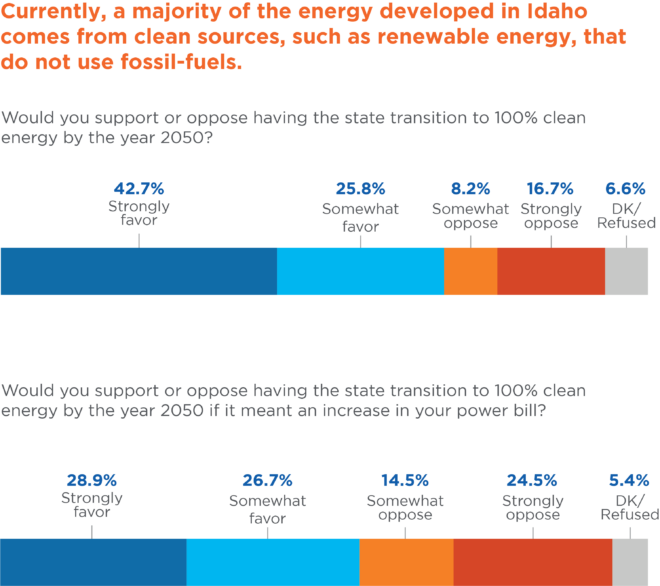
In the version presented where people were asked if they would support the transition to clean energy by 2050 if it meant paying more on their power bill, we observe a slightly different picture. We still see majority support for the goal when framed in this way with 55.6% in favor and 39% in opposition, but this is a nearly 13% drop in favorability compared to the baseline.
If people are generally supportive of shifting to renewable energy, there may be differences in support for different sources of energy. To explore this possibility, we presented Idahoans with four different kinds of renewable energy – solar, wind, hydro, and geothermal – and asked whether they favored or opposed increasing our use of these sources of energy. We find that large majorities support increasing the use of all four sources. Solar appears to be the most popular with 88.6% in favor of increasing our usage, followed by wind (79.2%), hydro (78.7%), and geothermal (76.6%) all with very similar levels of support. There are not any especially notable differences in support across groups, though younger Idahoans and Democrats are generally more supportive of all four than older residents and Republicans. Despite these differences, majorities of all groups are in support of increased usage. As we observed in the previous questions, increasing the use of solar energy is extremely popular with Idahoans. One
policy change that has been discussed to incentivize solar use is giving homeowners with solar energy systems a credit on their electricity bill for the energy that they add back to the power grid. When asked about their opinions on this, Idahoans express widespread support. 91.6% of respondents favor homeowners who have a solar energy system on their home receiving a credit
when they add power back to the grid, with 5.3% opposing this and 3.1% responding that they don’t know. There are no substantial differences across groups as all are very supportive.
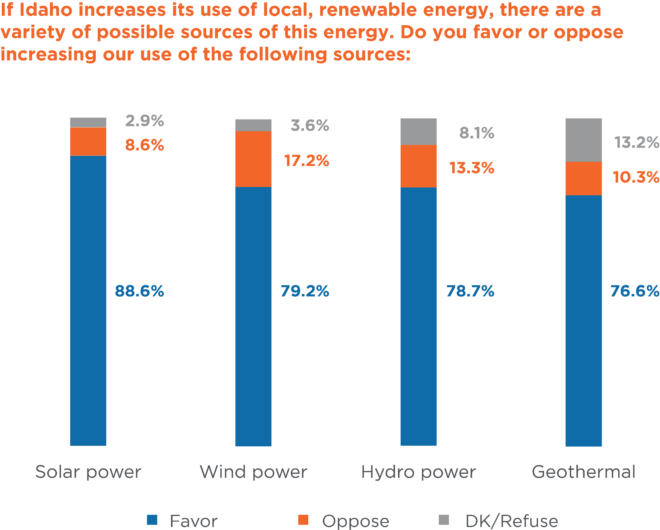
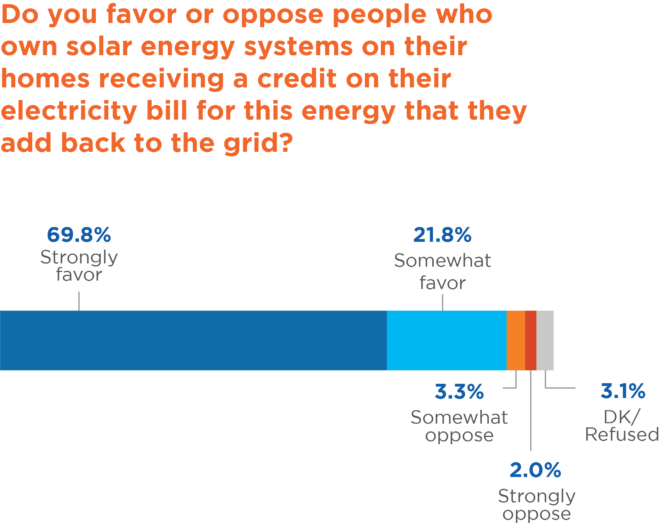
In sum, people are supportive of having the state transition to clean and renewable energy by 2050, but only narrowly so if it means increases to their power bills. With respect to different sources of clean energy, respondents favored increasing our usage of all of them, but solar energy emerged as the most popular. Further, Idahoans are overwhelmingly supportive of homeowners with solar units receiving a credit on their electrical bill for the power they put back onto the grid.